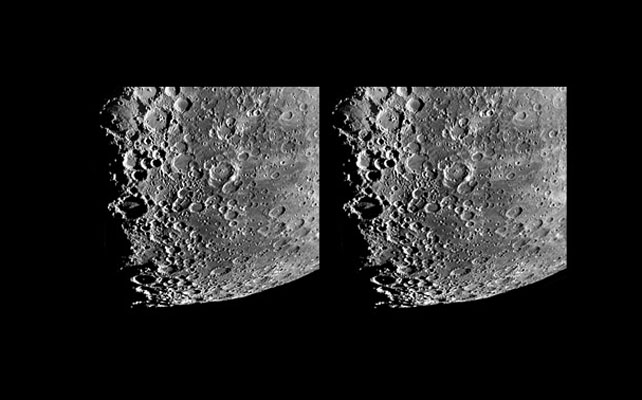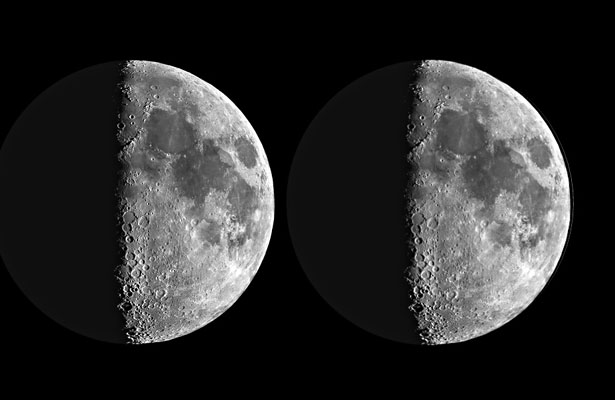Difference between revisions of "October 2, 2004"
| (12 intermediate revisions by the same user not shown) | |||
| Line 1: | Line 1: | ||
__NOTOC__ | __NOTOC__ | ||
=Stereo Moon= | =Stereo Moon= | ||
| + | <!-- Start of content --> | ||
<table width="85%" border="0" align="center" cellpadding="6" cellspacing="2"> | <table width="85%" border="0" align="center" cellpadding="6" cellspacing="2"> | ||
<tr> | <tr> | ||
| − | |||
<td width="50%"> | <td width="50%"> | ||
</td> | </td> | ||
| Line 11: | Line 11: | ||
<tr> | <tr> | ||
<td colspan="2" valign="top"><div align="center"> | <td colspan="2" valign="top"><div align="center"> | ||
| − | + | <!-- Mouse style 1 --> | |
| − | + | {{HoverImage|LPOD-2004-10-02.jpeg|LPOD-2004-10-02b.jpeg}} | |
| − | |||
</div></td> | </div></td> | ||
</tr> | </tr> | ||
| Line 19: | Line 18: | ||
<table width="80%" border="0" align="center" cellpadding="8"> | <table width="80%" border="0" align="center" cellpadding="8"> | ||
<tr> | <tr> | ||
| − | <td><div align="center" class="main_sm">Image Credit: [ j-p.metsavainio@myorigo.com J-P Metsavainio]</p> | + | <td><div align="center" class="main_sm"><p>Image Credit: [mailto:j-p.metsavainio@myorigo.com J-P Metsavainio]</p> |
</div></td> | </div></td> | ||
</tr> | </tr> | ||
| Line 26: | Line 25: | ||
<table class="story" border="0" bgcolor="#FFFFFF" width="90%" cellpadding="10" align="center"><tr><td> | <table class="story" border="0" bgcolor="#FFFFFF" width="90%" cellpadding="10" align="center"><tr><td> | ||
<p align="center"><b>Stereo Moon</b></p> | <p align="center"><b>Stereo Moon</b></p> | ||
| − | <p align="left">In the early 1900s, stereoviewers very popular parlor entertainments. A handheld [http://www.rleggat.com/photohistory/history/stereosc.htm stereoscope] allowed you to see two images, taken from slightly different angles, and fuse them in your brain to see stereo. Judging by the frequency that stereo images of the full Moon show up on eBay, the Moon was a popular object. The lunar stereo effect was achieved by using two images with different librations. J-P Metsavainio, who previously [ | + | <p align="left">In the early 1900s, stereoviewers very popular parlor entertainments. A handheld [http://www.rleggat.com/photohistory/history/stereosc.htm stereoscope] allowed you to see two images, taken from slightly different angles, and fuse them in your brain to see stereo. Judging by the frequency that stereo images of the full Moon show up on eBay, the Moon was a popular object. The lunar stereo effect was achieved by using two images with different librations. J-P Metsavainio, who previously [[June_21,_2004|demonstrated]] how to use Photoshop to digitally project lunar images on to a sphere and view from any perspective, has now realized that the same technique can be used to make stereo views using just one image! Here is a stereo pair of the heavily cratered southern hemisphere and on mouseover a first quarter Moon. I have one bad eye and thus can not see stereo but I am told that the image above has a strong stereo effect. See the stereo by placing your head about 10" from your monitor and looking at the left image with your left eye and the right one with your right eye. For small images 10" is about the right viewing distance - you may have to move back to 2 or 3 times that distance. And you may be helped by using a trick of the old stereoscopes - they had a small vertical board mounted near the eyepiece so that each eye could only see its image; you can hold a note card or even your hand vertically against your nose. After you achieve overlaping images and the stereo view, move closer to see details. J-P comments that by looking in stereo it feels like he can see more details. He also finds that this technique works with Jupiter. Happy viewing!</p> |
| − | <blockquote><p align="right">— [mailto:tychocrater@yahoo.com Chuck Wood]</blockquote> | + | <blockquote> |
| − | <p align="left" | + | <p align="right">— [mailto:tychocrater@yahoo.com Chuck Wood]</p></blockquote> |
| + | <p align="left"><b>Technical Details:</b><br> | ||
Stereo images are made by the same method as J-P's previous picture in LPOD. Use the PhotoShop 3D-rotation function to map the image onto a sphere, and then rotate the sphere somewhat to make a second image. The more the rotation, the stronger the stereo affect. Don't get dizzy! </p> | Stereo images are made by the same method as J-P's previous picture in LPOD. Use the PhotoShop 3D-rotation function to map the image onto a sphere, and then rotate the sphere somewhat to make a second image. The more the rotation, the stronger the stereo affect. Don't get dizzy! </p> | ||
<p><b>Related Links:</b><br> | <p><b>Related Links:</b><br> | ||
| − | [http://www.rleggat.com/photohistory/history/stereosc.htm Stereoscopic Photography] | + | [http://www.rleggat.com/photohistory/history/stereosc.htm Stereoscopic Photography]</p> |
| − | <p | + | <p><b>Yesterday's LPOD:</b> [[October 1, 2004|Julius Franz and Mare Orientale]] </p> |
| + | <p><b>Tomorrow's LPOD:</b> [[October 3, 2004|8” Marvel]] </p> | ||
</tr> | </tr> | ||
</table> | </table> | ||
| Line 43: | Line 44: | ||
<p align="center" class="main_titles"><b>Author & Editor:</b><br> | <p align="center" class="main_titles"><b>Author & Editor:</b><br> | ||
[mailto:tychocrater@yahoo.com Charles A. Wood]</p> | [mailto:tychocrater@yahoo.com Charles A. Wood]</p> | ||
| − | < | + | <!-- Cleanup of credits --> |
| − | + | <!-- Cleanup of credits --> | |
| − | < | + | <!-- Cleanup of credits --> |
| − | + | <!-- Cleanup of credits --> | |
| − | + | <!-- Cleanup of credits --> | |
| − | < | + | <!-- Cleanup of credits --> |
| − | < | + | <!-- Cleanup of credits --> |
| − | + | <!-- Cleanup of credits --> | |
| − | < | + | <!-- Cleanup of credits --> |
| − | + | <!-- Cleanup of credits --> | |
</td></tr> | </td></tr> | ||
</table> | </table> | ||
| − | ---- | + | <!-- End of content --> |
| − | + | {{wiki/ArticleFooter}} | |
| − | |||
Latest revision as of 15:00, 15 March 2015
Stereo Moon
Image Credit: J-P Metsavainio |
|
Stereo Moon In the early 1900s, stereoviewers very popular parlor entertainments. A handheld stereoscope allowed you to see two images, taken from slightly different angles, and fuse them in your brain to see stereo. Judging by the frequency that stereo images of the full Moon show up on eBay, the Moon was a popular object. The lunar stereo effect was achieved by using two images with different librations. J-P Metsavainio, who previously demonstrated how to use Photoshop to digitally project lunar images on to a sphere and view from any perspective, has now realized that the same technique can be used to make stereo views using just one image! Here is a stereo pair of the heavily cratered southern hemisphere and on mouseover a first quarter Moon. I have one bad eye and thus can not see stereo but I am told that the image above has a strong stereo effect. See the stereo by placing your head about 10" from your monitor and looking at the left image with your left eye and the right one with your right eye. For small images 10" is about the right viewing distance - you may have to move back to 2 or 3 times that distance. And you may be helped by using a trick of the old stereoscopes - they had a small vertical board mounted near the eyepiece so that each eye could only see its image; you can hold a note card or even your hand vertically against your nose. After you achieve overlaping images and the stereo view, move closer to see details. J-P comments that by looking in stereo it feels like he can see more details. He also finds that this technique works with Jupiter. Happy viewing! Technical Details: Related Links: Yesterday's LPOD: Julius Franz and Mare Orientale Tomorrow's LPOD: 8” Marvel |
|
Author & Editor: |
COMMENTS?
Register, Log in, and join in the comments.





